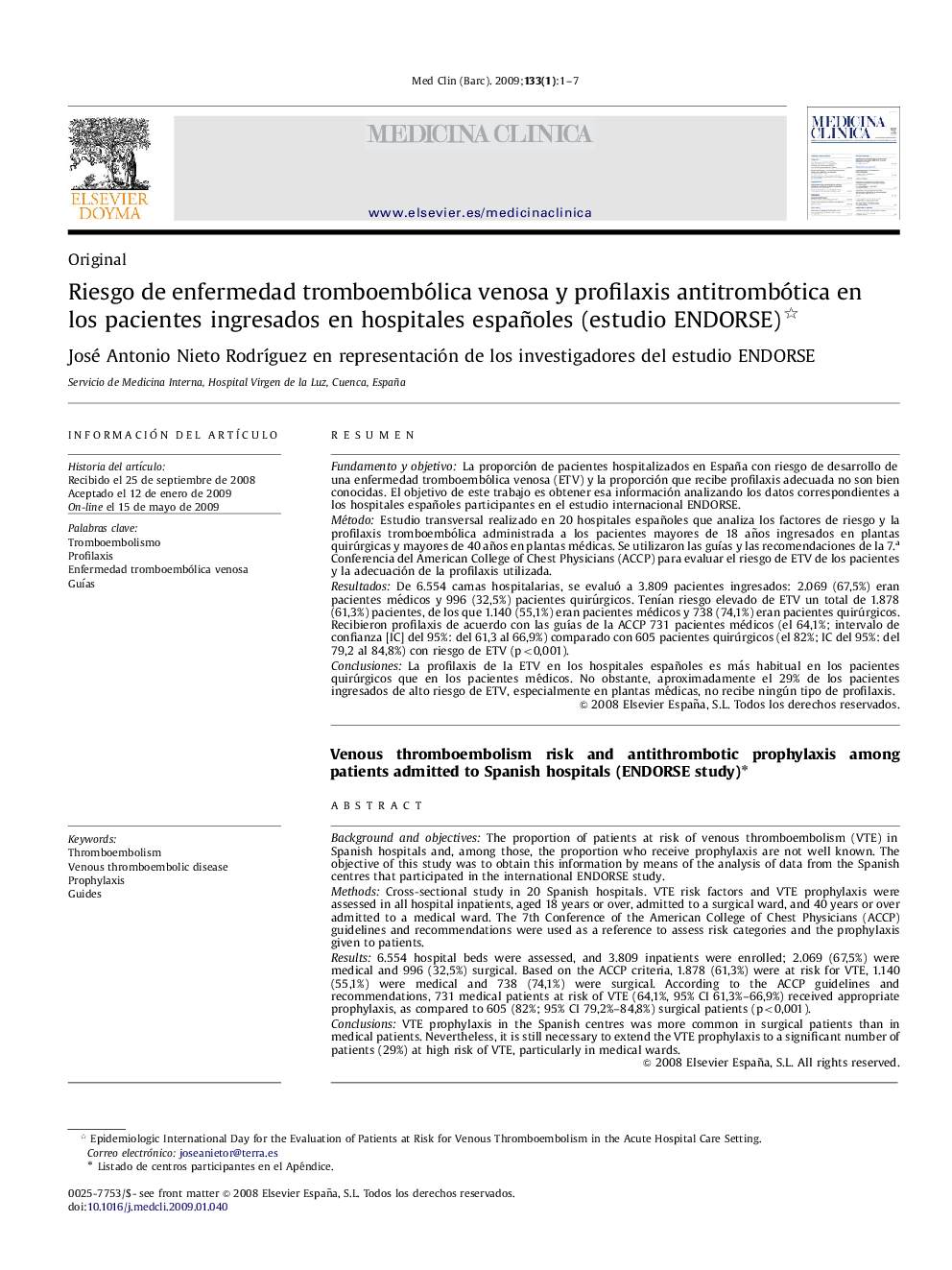| کد مقاله | کد نشریه | سال انتشار | مقاله انگلیسی | نسخه تمام متن |
|---|---|---|---|---|
| 3802845 | 1244838 | 2009 | 7 صفحه PDF | دانلود رایگان |

ResumenFundamento y objetivoLa proporción de pacientes hospitalizados en España con riesgo de desarrollo de una enfermedad tromboembólica venosa (ETV) y la proporción que recibe profilaxis adecuada no son bien conocidas. El objetivo de este trabajo es obtener esa información analizando los datos correspondientes a los hospitales españoles participantes en el estudio internacional ENDORSE.MétodoEstudio transversal realizado en 20 hospitales españoles que analiza los factores de riesgo y la profilaxis tromboembólica administrada a los pacientes mayores de 18 años ingresados en plantas quirúrgicas y mayores de 40 años en plantas médicas. Se utilizaron las guías y las recomendaciones de la 7.a Conferencia del American College of Chest Physicians (ACCP) para evaluar el riesgo de ETV de los pacientes y la adecuación de la profilaxis utilizada.ResultadosDe 6.554 camas hospitalarias, se evaluó a 3.809 pacientes ingresados: 2.069 (67,5%) eran pacientes médicos y 996 (32,5%) pacientes quirúrgicos. Tenían riesgo elevado de ETV un total de 1.878 (61,3%) pacientes, de los que 1.140 (55,1%) eran pacientes médicos y 738 (74,1%) eran pacientes quirúrgicos. Recibieron profilaxis de acuerdo con las guías de la ACCP 731 pacientes médicos (el 64,1%; intervalo de confianza [IC] del 95%: del 61,3 al 66,9%) comparado con 605 pacientes quirúrgicos (el 82%; IC del 95%: del 79,2 al 84,8%) con riesgo de ETV (p<0,001).ConclusionesLa profilaxis de la ETV en los hospitales españoles es más habitual en los pacientes quirúrgicos que en los pacientes médicos. No obstante, aproximadamente el 29% de los pacientes ingresados de alto riesgo de ETV, especialmente en plantas médicas, no recibe ningún tipo de profilaxis.
Background and objectivesThe proportion of patients at risk of venous thromboembolism (VTE) in Spanish hospitals and, among those, the proportion who receive prophylaxis are not well known. The objective of this study was to obtain this information by means of the analysis of data from the Spanish centres that participated in the international ENDORSE study.MethodsCross-sectional study in 20 Spanish hospitals. VTE risk factors and VTE prophylaxis were assessed in all hospital inpatients, aged 18 years or over, admitted to a surgical ward, and 40 years or over admitted to a medical ward. The 7th Conference of the American College of Chest Physicians (ACCP) guidelines and recommendations were used as a reference to assess risk categories and the prophylaxis given to patients.Results6.554 hospital beds were assessed, and 3.809 inpatients were enrolled; 2.069 (67,5%) were medical and 996 (32,5%) surgical. Based on the ACCP criteria, 1.878 (61,3%) were at risk for VTE, 1.140 (55,1%) were medical and 738 (74,1%) were surgical. According to the ACCP guidelines and recommendations, 731 medical patients at risk of VTE (64,1%, 95% CI 61,3%–66,9%) received appropriate prophylaxis, as compared to 605 (82%; 95% CI 79,2%–84,8%) surgical patients (p<0,001).ConclusionsVTE prophylaxis in the Spanish centres was more common in surgical patients than in medical patients. Nevertheless, it is still necessary to extend the VTE prophylaxis to a significant number of patients (29%) at high risk of VTE, particularly in medical wards.
Journal: Medicina Clínica - Volume 133, Issue 1, 6 June 2009, Pages 1–7